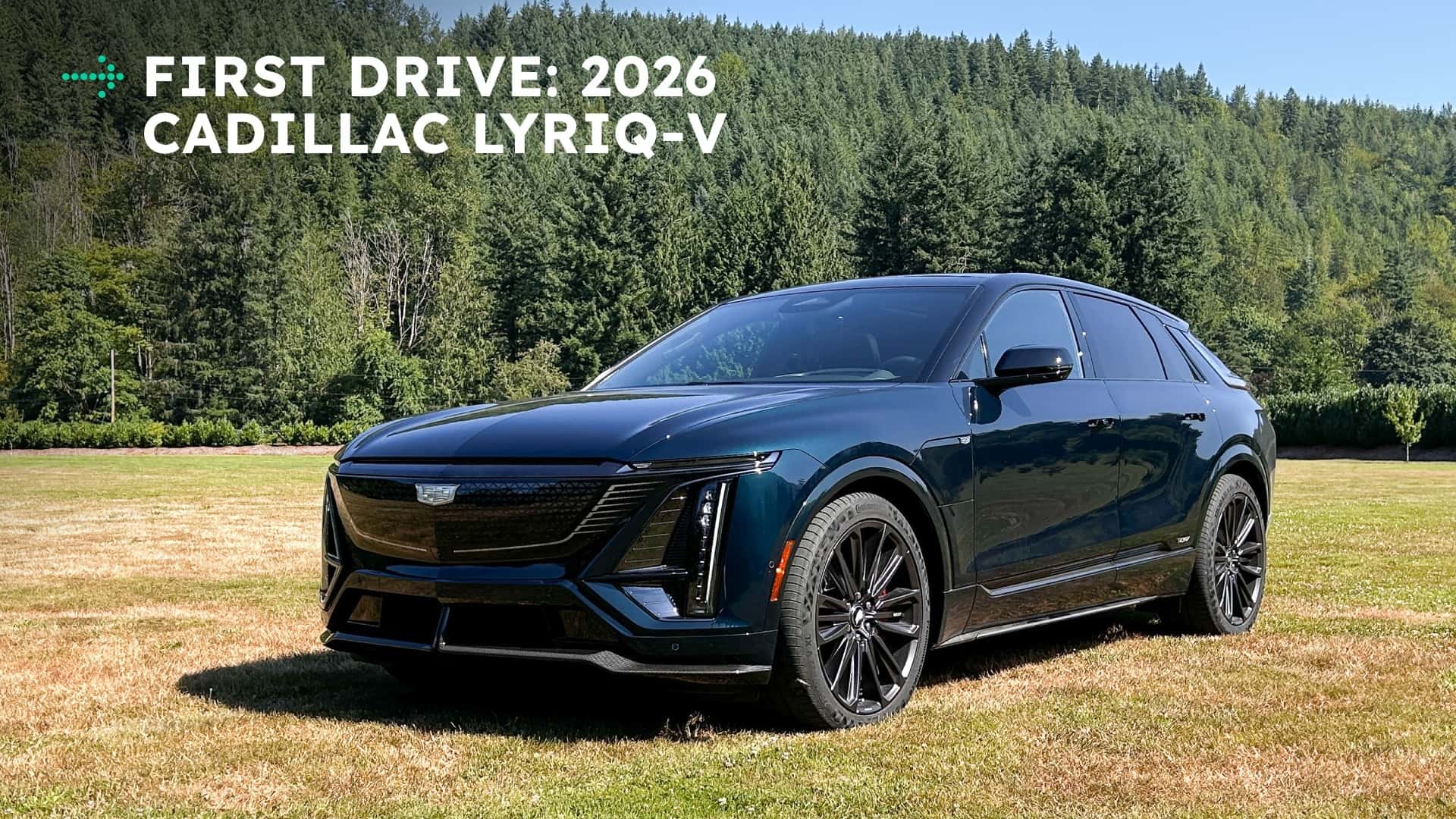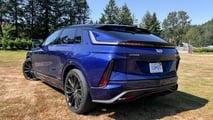
Cadillac’s got a hot hand. The brand’s electric-vehicle ambitions started rocky, with software issues that sullied the launch of the original Lyriq. But in the past year, it’s rolled out the Optiq, Vistiq, Celestiq and Escalade IQ, while the Lyriq has been refined and steadily rising in the sales charts.
This, then, is its crowning moment: With the core EV lineup established, and sales momentum building, Cadillac is taking the Lyriq to the next level with a 615-horsepower, tail-happy V model.
It rocks.
More than that, it’s proof that Cadillac’s early leadership in the EV space is no fluke. The brand is hungry, fast and quickly stealing buyers from competitors like BMW and Tesla. After two days of driving the Lyriq-V around Seattle, Washington, I don’t think the company is slowing down anytime soon.
Gallery: 2026 Cadillac Lyriq-V First Drive







(Full Disclosure: Cadillac flew me to Seattle, Washington and put me up in a nice hotel for the first drive of the Lyriq-V.)
What Is It?
The Lyriq was both Cadillac’s first EV, and a reset for the brand. With a long, low profile and dramatic proportions, the electric crossover has the gravitas of a late-Sixties Caddy and the sinister yet refined style of Anna Wintour. With over 500 hp, the all-wheel-drive Lyriq was already quick. But Cadillac’s V-Series is the brand’s equivalent to BMW M or Mercedes AMG—albeit now with Blackwing models taking things a step further. So the brand had to crank some dials.
Peak power grows to 615 hp, with 650 lb-ft of torque, thanks to reworked motors. That’s enough to make the Lyriq the quickest Cadillac ever: 0-60 in 3.3 seconds, outrunning even the tire-shredding CT5-V Blackwing from a set of lights. It’ll do the quarter mile in under 12 seconds and tops out somewhere north of 130 mph.
2026 Lyriq-V Specs
Frankly, in today’s world of super-powered EVs, those numbers aren’t anything surprising. They’re similar to the Chevy Blazer EV SS, which the Lyriq-V is closely related to. Yet Cadillac employs some of the best chassis engineers in the world, as any Blackwing driver will tell you. So the Lyriq-V gets stiffer and larger anti-roll bars, Sachs Continuous Damping Control (CDC) adaptive dampers, a retuned cooling system and a variety of new drive modes.
Chief among them is Competitive Mode, which uncorks the Lyriq-V’s full load of power, reduces stability control interventions and enables brake-based torque-vectoring to help the car get more tail-happy than it has any right to be. V-Mode is a step below that, sharpening up the suspension and whatnot, while “Velocity Max” mode is the mode you activate to get maximum power without affecting the chassis and steering settings.

Despite the aggressive running gear and standard summer performance tires, the Lyriq-V still manages to deliver 285 miles of EPA range—better than a ton of other “performance”-focused EVs. Like all Lyriqs, it can accept up to 190 kilowatts from a DC fast charger, and it’ll take around 40 minutes to do the 10-80% sprint, which is on the slow side of normal.
What’s Good?
God, all of it. The goal of an M, AMG or V car is to provide the comfort of a luxury car in everyday driving and the excitement of a sports car on a back road. As a 6,000-pound SUV, it’d be misleading to say the Lyriq-V is anything close to a sports car, but it is still a hoot to drive.
I felt its weight a bit too much on the autocross course Cadillac had set up for us, as it was easy to overload the front tires and scrub. But out in the real world, on flowing sweepers with lighter brake applications, the Lyriq was eager to turn and silly fun on the way out of corners. The car automatically grabs the inner brake to force power to its outside wheels during corners, and on corner exit in competitive mode it limits front axle torque to ensure you slide, rather than push, as you exceed the car’s limit.

Its sharp, tail-happy nature and 650 lb-ft of torque kept me smiling through winding Washington mountain roads.
But while it’s reasonably fun to drive—more so than most crossovers—the Lyriq is best as a laid-back grand tourer. Cadillac chose the Sachs CDC dampers primarily because of just how wide their range of adjustment is. The same shocks that keep the Lyriq flat and predictable on tight hairpins are utterly buttery in comfort mode, making the Lyriq-V an excellent city and highway cruiser.
It helps that even standard Cadillac EVs offer one of the best experiences in the luxury world. The software is crisp-looking and quick, and the interior looks great. Lyriq-Vs also get two of Cadillac’s best tech options as standard: Super Cruise hands-free driving and AKG surround sound.

Both were lifesavers as my buddy and I wormed our way through Seattle rush-hour traffic. Sitting in a massage seat with my hands off the wheel, listening to the Dolby Atmos mix of the new Wet Leg album, I felt more relaxed behind the wheel than maybe ever before in my life.
The Lyriq-V is a truly incredible daily driver. Then, when the road gets twisty, it’s damned good at that, too.
What’s Not So Good?
Still, this is a beefy electric crossover first and a performance product second. That means you really shouldn’t expect to be taking this thing to the race track, and you shouldn’t get one if driving engagement is your ultimate goal. The Lyriq is precise and nimble, but it has numb steering and a lot of inertia. As a performance crossover, it absolutely fulfills its mission. But those looking for a CT5-V replacement will need to wait for Cadillac to make a performance electric sedan, or at least for the lighter, smaller Optiq-V.
Plus, the Lyriq-V carries over some of the issues you may have with the regular version. The front seats are still a bit light on thigh support for taller drivers, with no extendable cushions. The rear seat still has a bar for the LATCH anchors that may oddly hit some rear-seat passengers’ lower backs. Its charging curve is still odd and far from the top of the class, though the engineers say that cooling has been improved to solve any hot-weather charging issues.

Any Ultium EV owner knows the other two main issues. A Lyriq engineer confirmed that, internally, General Motors has two top priorities for future EVs: reduce mass and improve packaging. The Lyriq-V, with its 5,980-lb curb weight and no frunk under that massive hood, is a key example of why GM needs to work on those things.
Verdict: I Don’t Care, This Rules
Frankly, I don’t care about the weight. As a former owner of a Honda S2000 and two different Mazda Miatas, I’ve long bemoaned the curb weights of these big EVs. But the Lyriq-V is proof that the excess weight is a worthwhile tradeoff for such a wonderful car. It takes advantage of the key benefits of electric motors: It is effortlessly fast, endlessly smooth and utterly silent in everyday operation. The Lyriq-V’s powertrain is better than any internal-combustion engine could ever hope to be, and it’s simpler, too.
This is why EVs are going to win out. Because the Lyriq-V isn’t just an electric alternative to a BMW X5 or Lexus RX. It’s a wholly better product, with better performance, better software and simple components that will be easy to replace and maintain over time. It is flawless in traffic and a riot to drive fast, as effortless as it is sophisticated.
For my money, it’s one of the best daily drivers in the world. It blends the best of old-school American luxury—big cabins, pothole-proof suspensions and long, dramatic profiles—with the versatility and simplicity of a modern software-defined EV.
It’s a reminder, then, that the transition to EVs is not an obligation for brands but an opportunity. Cadillac, ascendant, back from its comatose years, now holds a commanding position in the luxury EV market. That comes from one simple truth: Done right, a modern luxury EV is just a better experience than a gas alternative.
Cadillac was just smart enough to see that, and its early bet has already paid off.
Contact the author: Mack.Hogan@insideevs.com.







